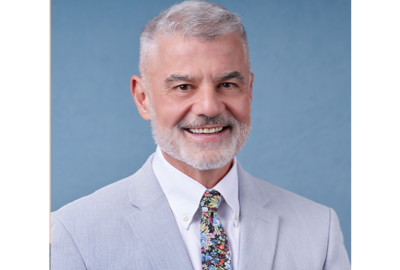Whole-of-government suicide-prevention strategy
The federal government has a new strategy to prevent suicide.
The federal government has a new strategy to prevent suicide. It is the first time the strategy has been updated in a decade, and the agencies leading the effort say it will be a whole-of-government and whole-of-society approach. And, for the first time, the new strategy comes with a detailed action plan that lays out exactly what federal agencies will do – including some agencies you might not necessarily think of when it comes to suicide prevention. Brandon Johnson is Chief of the Suicide Prevention Branch in the Substance Abuse and Mental Health Services Administration. He’s spoke with Federal News Network’s Jared Serbu on the Federal Drive with Tom Temin.
Interview Transcript:
Jared Serbu And I think we’d like to start as if you could just start us off with a little bit of data. My sense is that’s really underpinned a lot of what you’re doing here. And, you know, that’s this is not just motivated by the fact that it’s been ten years and it’s time, but there are some specific reasons that that inform the development of this strategy. So, talk about some of that with you.
Brandon Johnson Yeah, absolutely. I would love to get into some of that. Well, essentially what’s been happening specifically in suicide prevention and suicide in this country is that there’s been a consistent increase, really since around, the 2000 that there’s been consistent increases in the suicide rate, across the country. What we’ve seen really from, from then in the latter day came out in 2012. But what we’ve been seeing is about, you know, since 2000, it’s been like a 30% increase, 36% increase, maybe overall, 30% in, in males and about 40% in, in women. But consistently we’ve been seeing these increases, except for a small dip in 2020. We’ve been seeing consistently, consistent increases in the suicide rate across the country. I think in particularly some of the things that we’ve found to be most striking, I think in recent years has been this development of, increases in the suicide rate among specific populations that actually weren’t increasing previously. So, there’s been, you know, consistent increases maintained in these populations, disproportionately impacted by suicide, for a long time. So, looking at, middle aged white males, especially those in rural communities, looking at American Indian, Alaska Natives, looking at veterans as well, those groups have historically been higher. But what we’ve seen is increases in suicide attempts among LGBTQ plus, young people in particular, African American black youth had a significant increase in their suicide rate between the ages of 10 to 24 from 2008 to 2021. And we’ve also seen an increase in Hispanic youth, as well. So, looking at this data, we’re looking at where rates are and how things have been impacted. What we wanted to do was also address these specific things and these specific trends in increases, in suicide across the country. I think we’re putting together this document.
Jared Serbu Yeah. And that takes us directly into one of the things that is new in this strategy, which is the equity pillar. Talk us through some of the thinking behind that. And what are the reasons why you specifically target equity in a strategy like that? Is it that, you know, some of the policy interventions that we have in place and know how to do just we’re not serving these communities?
Brandon Johnson Yeah, I think there’s a I think there’s a mix of two things. I think generally speaking, one of the ways that we’ve seen, you know, we really wanted to look at what advancements do have we had since the last strategy. And I think this idea of, more targeted suicide prevention activities, versus those that are universal, a really good opportunity to speak directly to the risk and protective factors, the societal challenges, the unique community aspects of some populations that I mentioned previously where we’ve seen trends increase. But also looking at those, groups that have been disproportionately impacted and some groups that have been left out of the conversation. So, we really wanted to have an opportunity in this strategy to look at how to do, how to incorporate health equity in suicide prevention. So how do we look at data and trends in, these various populations and really assess what are the risk and protective factors there? How can we intervene that meets the needs of these specific populations? And then how do we include them in the work? So not just you know, developing a program or intervention that says, you know, what we think, this will work for this population, like, you know, speak to them, right. I think really doing what I call a really good public health work and engaging the community in, the prevention strategies and the development of interventions and really having those, those conversations and developing these things in tandem with the resources that we have that can really speak to what’s driving the suicidal behavior within these populations. And then looking at a community such as those with, developmental disabilities or other disabilities who haven’t necessarily been at, that the forefront in the minds of folks in suicide prevention, this gives us an opportunity to identify those, those groups and understand if, you know, we’re not looking at the data with these groups, then why aren’t we are we not collecting it? Do we not knowing how we improve our overall data systems, to engage these populations. So really the health equity section goes into details on all of that. It calls out specific groups and populations that we should be thinking about. And also, how do we accomplish this as well.
Jared Serbu And then I want to talk about some of the specific roles for federal agencies under this action plan. I think there’s 20 maybe more than that involved here with different roles. And I imagine that’s kind of a complex mix, right? Because I I’m guessing you’ve got some like DoD, VA, IHS that have more of a direct provider. They’re directly touching patient’s role in the, in the behavioral health system and in some others that are a couple steps removed from the individual. So, talk about some of the specific things that different agencies are going to be doing depending on what their missions are.
Brandon Johnson Yeah, I think the and just so, so folks are aware about the federal action Plan, this was a one of a kind document that we were able to put out in tandem with the strategy where, our federal agencies, I think is closer, around 29 federal agency, ten federal departments, that were able to, really add some action items to this. And so, we have over 200 action items that federal agencies are taking to advance the goals and the objectives, which is really exciting for us. And so in terms of kind of where agencies are looking at as a part of this, I think what we’re in this process of developing these action plan items, when we were working with the federal agencies, what we wanted to do was, you know, encourage them to really focus on populations that they serve, regions that they serve where they have, you know, kind of work already happening with specific populations. And how do we, take that to another level and kind of do some, some innovation as well? And so, in this, I think the actions across the different agencies, like you said, it really does, does vary. So, if you look at, the Indian Health Service, for example, like one of their goals was specifically around, universal, screening, suicide risk screening across all of their healthcare systems, in their facilities. And so, as we look at that, they have reached, down to the ground at the, the local level within tribes, tribal communities, tribal nations, to really do this work, at that level. So, implementing universal suicide risk screening across these populations really gets to the level of the work, that they’re doing and being able to reach that population. If you look at, USDA, one of their action plan items is around, supporting mobile crisis teams throughout, rural communities and how to disseminate information there. Because that’s where they have their reach. And so, they’re able to improve that service within rural communities because it’s an opportunity in a place that they’re already working. And if you look at, you know, some action items from us, SAMHSA, we’re really talking about engaging state suicide prevention coordinators that we have major relationships with. As we’re doing this work and, and really trying to get things at the state and the local level, because a lot of our grants are serving at that level. So, we have an action plan item that focuses on, getting, it’s disseminating practices that speak to risk factors and social determinants of health related to suicide prevention. And how do we take that and tailor it for states and communities and get that information down to them, and also help them with materials that they can use and create to actually advance the work in this area. And, you know, you take NIH, and they are definitely talking around their research. And because that’s their lean. Right. And so, I think looking at this and looking across the action plan items, I think you’ll find, a really healthy mix of action plan items. Some are a little broader and like a resource base, some drill down, to local communities with like IHS, but it really kind of varies across all the federal agencies. But I think we really got a good mix there. We have action, items across all of the goals within the strategy. So, this is really an opportunity to kind of address suicide across a number of different fronts. With all of our agencies really kind of thinking about where can they have the most impact. And we’re hoping that all of this work collectively drives a decrease in suicide rates.
Jared Serbu Super interesting. I never would have guessed that a USDA, for example, has a role in suicide prevention. I’d like to talk about how that kind of thing adapts over time. Ten years is a long-time horizon, right? I’m sure it was hard enough to get everybody on one page as a one-time event to develop one strategy. How do you make sure this this flexes as it needs to during those ten years? As you learn more and more about what’s working and what’s not.
Brandon Johnson That’s a really great question. And so, what we did was that we really wanted to address that very thing which you brought out. So, the strategy itself is a ten-year strategy. So, the strategy will be in place for the next ten years. The federal action plan is around for three fiscal years. So, at the end of the three fiscal years, we’re kind of assess, really where we are with the action plan items. And so, if there are needs to pivot or needs to, to kind of take some action. Oh four. If any disease want to develop new action plan items, and we’ll be able to do that and then be able to release it and, and adjust to the current, federal action plan. So, this gives us the opportunity to monitor and assess what we’re doing when we we’re working with the federal agencies to really develop their action plan items. We task them with ensuring that these are items, that they would have some measure of success if they know that this is having impact, that this is really moving the needle is doing what it’s intended to do. And so, we hope to take a look at that in a few fiscal years and see where things are and make some adjustments. And so this way if things are changing in the field, if we get new, new innovation again, as, with us and having the 90 day crisis line here as well, there are adjustments to the data or new populations that we want to hear that we’d be able to, to make those adjustments in real time. So, this gives us that flexibility to make adjustments when needed.
Copyright © 2024 Federal News Network. All rights reserved. This website is not intended for users located within the European Economic Area.
Jared Serbu is deputy editor of Federal News Network and reports on the Defense Department’s contracting, legislative, workforce and IT issues.
Follow @jserbuWFED






